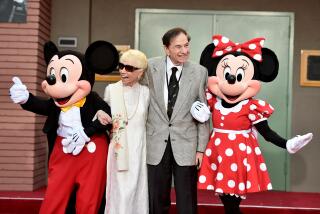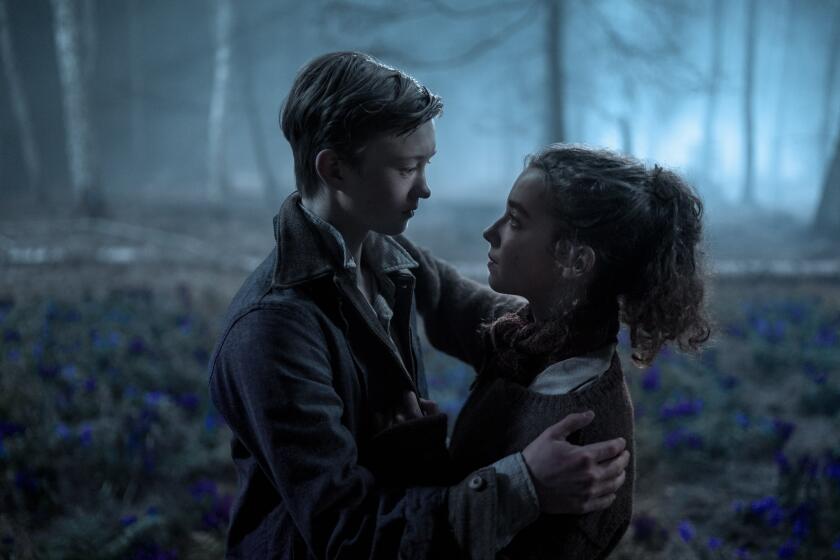Frank, Ollie Ride Again : Legendary Animators Are Subjects of a Documentary About Disney Heyday
Lifelong friends Frank Thomas and Ollie Johnston have given expressive performances in a lot of famous movies. But until now they’ve spent little time on-screen.
For years, the eightysomething artists have lived a quiet, comfortable retirement in next-door houses in La Canada Flintridge. Frank still plays the piano and Ollie still plays with the miniature train that loops around his back yard.
But each also reads about 10 letters a month asking for advice or sketches, mostly from fans who remember them as two of Walt Disney’s “Nine Old Men,” a legendary team of animators who played key roles in the creation of “Snow White and the Seven Dwarfs,” “Fantasia,” “Bambi” and other cartoon classics.
As a new animation craze sweeps Hollywood, Frank and Ollie--as virtually everyone refers to them now--are credited with pioneering important techniques and developing emotional depth in caricatures. But they recall stumbling upon many of their best discoveries almost by accident.
“It was a slow process,” said Frank, 83. “Almost every guy there [at the Disney studio] was contributing something. But no one knew what we were looking for.”
Now comes “Frank and Ollie,” a new documentary by Frank’s son Theodore Thomas, which sees their groundbreaking work as the product of an extraordinarily long-running friendship. The film opens Friday for a one-week engagement at the AMC Century City theater, with plans for wider release in February.
The younger Thomas, a 44-year-old documentarian whose previous credits include the PBS series “Planet Earth,” struggled for seven years to raise money and get permission to use short clips for his film.
“There were plenty of opportunities to tell Walt stories or dish dirt or do more of a greatest hits compilation from the animated classics,” he said. “But we wanted to keep the focus always on the relationship between the two guys. They made these films because of who they are.”
What emerges is a portrait of a virtually ego-free collaboration--albeit one shaped for many years by a paternalistic employer named Walt Disney. The elderly animators appear to share an understanding beyond words. In the documentary, as in real life, they reveal a habit of completing each other’s thoughts and sentences.
When a reporter asked how they are different, the pair paused for a beat and then Ollie, 82, replied: “Well, Frank has more hair.”
He laughed. “He’s more analytical than I am,” Ollie said, sitting on the living-room sofa of his rambling ranch house. A nearby shelf is lined with a dozen or so videos of their Disney features. “I’m more intuitive.”
But Frank leaned forward and added: “We both think along the same lines.”
They have lived along the same lines, too. After studying art at Stanford University, the pair migrated to Los Angeles in the 1930s, as Walt Disney was launching what would later be considered the golden age of screen animation.
As junior members of Disney’s team, the young artists began tackling the unprecedented problems facing early animators. They had to find ways of drawing people and animals that could capture viewers’ attention and sympathy for an hour and a half. How could you make an audience identify with, say, a cartoon dwarf? How could you make a talking deer, in Ollie’s words, “not realistic, but believable”?
“If you look at Bambi beside a real deer, they don’t look much alike,” Ollie said. “A real deer has a long, pointed muzzle, but you couldn’t have animated that. . . . It wasn’t the drawing [that was important], it was what the character felt.”
To arrive at that feeling, the animators became performers themselves. In “Frank and Ollie,” they are shown acting out roles from “The Jungle Book” and other films, much as they remember doing when drawing the original scenes.
The duo also contributed to the development of several techniques still used by animators today. Among them is what they refer to as “squash and stretch,” which showed how exaggerating movement and the pull of gravity could make a series of drawings more convincing.
Presiding over this process was Walt Disney himself, whom the pair remember as an astonishingly gifted--and autocratic--boss. In the midst of story meetings in his Burbank office he would often jump up and leap around to demonstrate how a character should move on-screen. But Disney could also be brusque and highly critical of work he considered inferior, the animators say.
He also would not allow any animator to take sole credit for a character in a film.
“People talk about Walt Disney not giving credit to artists, but he also protected artists,” Theodore Thomas said. “They never had to take hits from critics, raise money or answer to an unsupportive public. All they had to do was go to this sheltered environment and be creative.”
After the commercial failure of “Fantasia” in 1940, the animators say, Disney lost much of his enthusiasm for feature-length cartoons. He began to direct his attention toward other projects, such as live-action movies, theme parks and TV shows. But Frank and Ollie continued working on animated films, even after Disney’s death in 1966.
“What we missed were [his] ideas,” Ollie said. “We tried not to say, ‘How would Walt do this?’ But he had educated us. On ‘The Aristocats,’ we had a lot of struggling with the story, but I think we got some pretty good characters.”
They retired in the late ‘70s, when the studio was near its nadir. Since then they’ve co-authored four books about Disney animation and still give occasional lectures on the craft. But they remain skeptical of the current cartoon boom, which has seen many animators’ salaries zoom well into the six-figure range. Even recent Disney blockbusters such as “The Lion King” and “Beauty and the Beast,” they argue, place too much emphasis on action above character.
Theodore Thomas had a different set of issues with the current Disney management. Seizing upon the idea for the documentary in 1987, he and his wife, producer Kuniko Okubo, spent the next seven years piecing together the $650,000 budget and trying to persuade the studio to cooperate without wresting control over the film.
“We couldn’t make it with [financing from] Disney, because we all knew they couldn’t resist the temptation to use it as a promotional film,” Thomas said. “But we also knew we couldn’t make it without Disney because we needed the film clips.”
Thomas and studio executives eventually agreed that he could use the clips and keep creative control, provided that Disney would own the resulting picture. This arrangement meant that Disney was under no obligation to distribute the film. Luckily, the studio brass liked the film.
So do its subjects. But the two animators seem a lot more comfortable as old friends than leading men. Ollie began to talk of his fascination with trains, noting that he began laying tracks for his miniature set the very day he moved into his Flintridge home in 1947.
Did he ever build a line over to Frank’s house next door?
Here Frank cut in. “No, Ollie just built it in his own yard,” he said. “That way, everybody else would be on the wrong side of the tracks.”
More to Read
Only good movies
Get the Indie Focus newsletter, Mark Olsen's weekly guide to the world of cinema.
You may occasionally receive promotional content from the Los Angeles Times.











